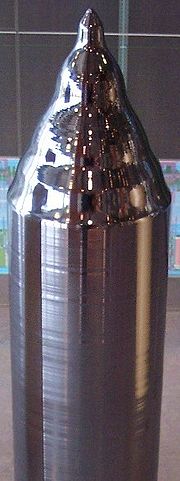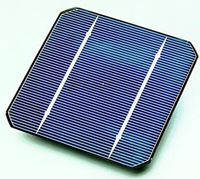
Monocrystalline silicon
Encyclopedia

Silicon
Silicon is a chemical element with the symbol Si and atomic number 14. A tetravalent metalloid, it is less reactive than its chemical analog carbon, the nonmetal directly above it in the periodic table, but more reactive than germanium, the metalloid directly below it in the table...
in which the crystal lattice of the entire solid is continuous, unbroken (with no grain boundaries) to its edges. It can be prepared intrinsic
Intrinsic semiconductor
An intrinsic semiconductor, also called an undoped semiconductor or i-type semiconductor, is a pure semiconductor without any significant dopant species present. The number of charge carriers is therefore determined by the properties of the material itself instead of the amount of impurities...
, i.e. made of exceedingly pure silicon alone, or doped
Doping (semiconductor)
In semiconductor production, doping intentionally introduces impurities into an extremely pure semiconductor for the purpose of modulating its electrical properties. The impurities are dependent upon the type of semiconductor. Lightly and moderately doped semiconductors are referred to as extrinsic...
, containing very small quantities of other elements added to change in a controlled manner its semiconducting
Semiconductor
A semiconductor is a material with electrical conductivity due to electron flow intermediate in magnitude between that of a conductor and an insulator. This means a conductivity roughly in the range of 103 to 10−8 siemens per centimeter...
properties. Most silicon monocrystals are grown by the Czochralski process
Czochralski process
The Czochralski process is a method of crystal growth used to obtain single crystals of semiconductors , metals , salts, and synthetic gemstones...
, in the shape of cylinders up to 2 m long and 30 cm in diameter (figure on the left), which, cut in thin slices, give the wafer
Wafer (electronics)
A wafer is a thin slice of semiconductor material, such as a silicon crystal, used in the fabrication of integrated circuits and other microdevices...
s onto which the microcircuits will be fabricated.
Single-crystal silicon is perhaps the most important technological material of the last decades (the "silicon era"), because its availability at an affordable cost has been essential for the development of the electronic devices on which the present day electronic and informatic revolution is based.
Amorphous silicon
Amorphous silicon is the non-crystalline allotropic form of silicon. It can be deposited in thin films at low temperatures onto a variety of substrates, offering some unique capabilities for a variety of electronics.-Description:...
, in which the atomic order is limited to short range order only. In between the two extremes there is polycrystalline silicon
Polycrystalline silicon
Polycrystalline silicon, also called polysilicon, is a material consisting of small silicon crystals. It differs from single-crystal silicon, used for electronics and solar cells, and from amorphous silicon, used for thin film devices and solar cells....
, which is made up of small crystals, known as crystallite
Crystallite
Crystallites are small, often microscopic crystals that, held together through highly defective boundaries, constitute a polycrystalline solid. Metallurgists often refer to crystallites as grains.- Details :...
s.
Mono-Si in electronics
The monocrystalline form is used in the semiconductor device fabrication since grain boundaries would bring discontinuities and favor imperfections in the microstructure of silicon, such as impuritiesImpurity
Impurities are substances inside a confined amount of liquid, gas, or solid, which differ from the chemical composition of the material or compound.Impurities are either naturally occurring or added during synthesis of a chemical or commercial product...
and crystallographic defect
Crystallographic defect
Crystalline solids exhibit a periodic crystal structure. The positions of atoms or molecules occur on repeating fixed distances, determined by the unit cell parameters. However, the arrangement of atom or molecules in most crystalline materials is not perfect...
s, which can have significant effects on the local electronic properties of the material. On the scale that devices operate on, these imperfections would have a significant impact on the functionality and reliability of the devices. Without the crystalline perfection, it would be virtually impossible to build Very Large-Scale Integration (VLSI) devices (figure at right), in which millions (up to billions, circa 2005) of transistor-based circuits, all of which must reliably be working, are combined into a single chip to get e.g. a microprocessor. Therefore, electronic industry has invested heavily in facilities to produce large single crystals of silicon.
Mono-Si in solar cells

Solar cell
A solar cell is a solid state electrical device that converts the energy of light directly into electricity by the photovoltaic effect....
s. Since, however, solar cells are less demanding than microelectronics for as concerns structural imperfections, monocrystaline solar grade (Sog-Si) is often used, single crystal is also often replaced by the cheaper polycrystalline or multicrystalline silicon
Polycrystalline silicon
Polycrystalline silicon, also called polysilicon, is a material consisting of small silicon crystals. It differs from single-crystal silicon, used for electronics and solar cells, and from amorphous silicon, used for thin film devices and solar cells....
. Monocrystalline solar cells can achieve 17% efficiency whereas other types of less expensive cells including thin film
Thin film
A thin film is a layer of material ranging from fractions of a nanometer to several micrometers in thickness. Electronic semiconductor devices and optical coatings are the main applications benefiting from thin film construction....
and polycrystalline
Polycrystalline
Polycrystalline materials are solids that are composed of many crystallites of varying size and orientation. The variation in direction can be random or directed, possibly due to growth and processing conditions. Fiber texture is an example of the latter.Almost all common metals, and many ceramics...
are only capable of achieving around 10% efficiency.
Few solar charger companies use monocrystalline solar panels because of the higher cost to produce the solar cells, although these higher efficiency products are starting to pop up as consumers demand more efficient products. The 2010 Consumer Electronics Show
Consumer Electronics Show
The International Consumer Electronics Show is a major technology-related trade show held each January in the Las Vegas Convention Center, Las Vegas, Nevada, United States. Not open to the public, the Consumer Electronics Association-sponsored show typically hosts previews of products and new...
showcased one of these high-efficiency monocrystalline chargers known as the JOOS Orange and awarded it the 2010 Best of Innovations Award. The charger is manufactured by SolarJOOS
SolarJOOS
SolarJOOS is a solar power company founded in 2008. The company builds an efficient and rugged portable solar charger used to charge cell phones and other portable electronic devices...
, a Silicon Valley based solar company.

